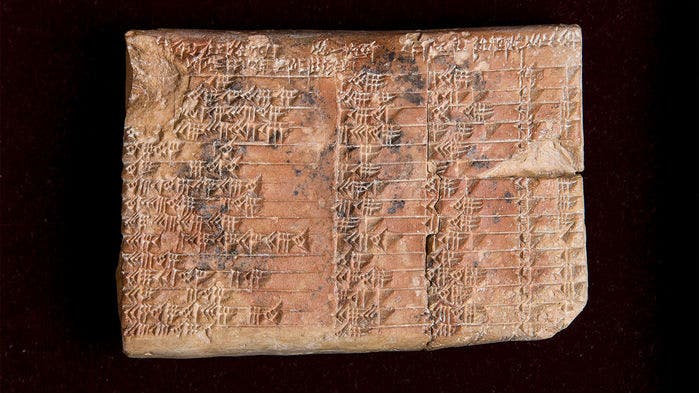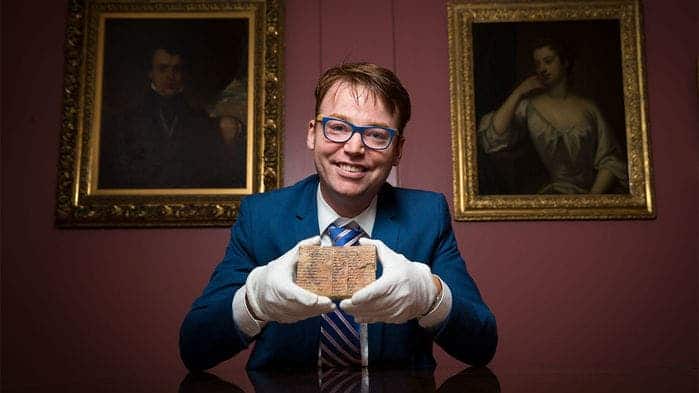For almost a hundred years, a mysterious clay tablet known as Plimpton 322 has baffled scientists as to its true meaning. Now, a pair of Australian mathematicians claim they’ve cracked the ancient Babylonian tablet which astonishingly might be a sort of trigonometrical table. If this is indeed true, then the Babylonians may have beat the Greeks to it by about 1,000 years. There are critics who aren’t convinced, though.

Cuneiform inscriptions on the Plimpton 322 clay tablet suggests these are ratios for the sidea of a triangle. Credit: UNSW.
From Indiana Jones to Pythagoras
Plimpton 322 was discovered in the early 1900s around southern Iraq by a very curious character named Edgar Banks. An antique dealer, diplomat, archaeologist and professor, Banks is one of the most famous early 20th century archaeologists and the man who largely served as inspiration for Indiana Jones.
From Iraq, the table found its way to the hands of New York publisher George Arthur Plimpton in 1922, to whom Banks sold it for $10. The artifact remained in Plimpton’s private collection before being donated to Columbia University upon Plimpton’s death where it’s housed to this day.
The mathematical importance of the cuneiform scribblings came to light in the 1940s when historians realized that these look like series of numbers eerily reminiscent of the Pythagorean theorem. Despite renewed interest, no one has been able to make much of Pimpton 322 since. But as it sometimes happens, great discoveries can surface from the unlikeliest of situations.
Mathematician Daniel Mansfield of the University of New South Wales (UNSW) was tasked with making a course for high school math teachers when he came across a digital image of Plimpton 322. He told colleague Norman Wildberger about it and ever since the two have been trying to distill its meaning.
The tablet is arranged in a series of 15 rows intersected by four columns. It doesn’t have any of the familiar values for cosines, sines, or angles you would expect to see in Greek writings — or modern trigonometry for that matter. After two years of work though, the two Australian researchers concluded that the values listed in the table are indeed trigonometrical. These represent the ratios of various triangle sides, not angles. Namely, the table lists information on two sides of a right triangle: the ratio of the short side to the long side and the ratio of the short side to the diagonal, or hypotenuse.
In fact, the most notable evidence that prompted Mansfield and Wildberger to claim they’re dealing with trigonometry was the Pythagorean triples etched in cuneiform. These are positive integers that fit the rule a2 + b2 = c2 , for instance, 3, 4, 5 or 9, 16, 25 are all Pythagorean triplets. That’s striking seeing how it would take another 1,000 years before Pythagoras was born.

Australian mathematicians Daniel Mansfield pictured holding the the 3700-year-old Babylonian tablet that he claims was used for trigonometry — it would make it the earliest such instance in history. Credit: UNSW.
Mere mathematical speculation?
The top row of the table shows relatively equal ratios that added together output near equilateral triangles. Moving down the table, the ratios decrease and so does the triangle’s inclination, lending narrower triangles.
Researchers speculate that such tables were likely used by Babylonian engineers to derive integrals instead of fractions since it uses a base number of 60 or a hexadecimal system. The tablet would be very useful to survey crop fields or in constructions where it would be very easy to design a pyramid slope simply by known the width and height of a surface.
“It is a fascinating mathematical work that demonstrates undoubted genius,” Mansfield said in a press release.
Not everyone is convinced, though. The left-hand edge of the tablet is broken and some believe the original was built with 38 rows. That being said, this is a table of outputs and absent the process we can only make an educated guess as to the true meaning of these values.
“Apart from the column headings, the tablet just consists of columns of numbers, and this invites a great deal of purely mathematical speculation,” said Duncan Melville is a professor of mathematics at St. Lawrence University in an emailed statement to National Geographic. “Some of the different interpretations for construction of the tablet are mathematically equivalent and so just having the output on the tablet does not tell you much about the process used to generate that output.”
If indeed this is indeed not an incidental table of right triangles with whole numbers as sides, then the Babylonians beat Greek astronomer Hipparchus — widely assumed as the father of trigonometry — by roughly 1,000 years. It would be odd, however, to have this as the only instance of Babylonian trigonometry in the span of a millennium, which is why critics abound.
For now, whether Pimpton 322 is a trigonometry table remains a seductive idea; one that may be proven or disproven after more analysis.









